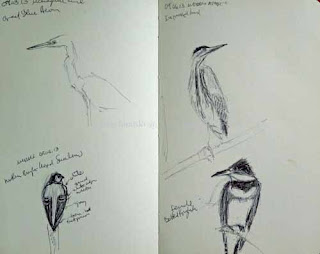 |
| Eastern Wood Pewee with Dragonfly. Watercolor sketch by Ken Januski |
For some perverse reason I have a desire to portray flycatchers that is almost as strong as that of my desire to portray the estimable wood warblers. And yet the flycatchers just don't hold a candle in terms of beauty. They are attractive, no doubt at all, but they don't quite excite people the way the warblers do.
My guess, and that's all it is, is that because the flycatchers are hard to differentiate you need to look at them closely. And if you're an artist you need to do so even more. You need to see elements that not only define the species but allow you to put them down on paper. I'm only talking about the few flycatchers that are seen in the east by the way. I might just give up if I had to contend with western flycatchers. It may be that this is a challenge that I find hard to pass up. Learing bird identification and improving my drawing skills at the same time.
I find it exciting each time that they're around, whether the common Acadian Flycatchers which are here all summer each year or the much rarer, at least here, Least Flycatcher.
Fall seems to be the most exciting but also the hardest time for flycatchers. I think that's because there are more migrants around and there are both adults and young. That's a lot to look closely at, particularly if they're not vocalizing.
Above is a common flycatcher of the area, the Eastern Wood Pewee. I saw a couple of them yesterday at Morris Arboretum. The one above was quite near me and I took numerous photos of him as he tried to digest a dragonfly. There were hundreds in flight yesterday during the four hours that I was out. I believe that the one he's captured above is a Common Green Darner.
When you see that number of dragonflies it's easy to see how they are a popular food for some birds. Since I've come to be fascinated by dragonflies recently I'm in no hurry to see them meet their end, to show their part in the 'nature red in tooth and claw' scenario. On the other hand the more you observe nature you do see this aspect to it. Recent researchers have also written on the cooperative aspect that can be found in nature as well but I don't want to digress too far. In any case I'm not bothered as I see the birds devouring the dragonflies. It is part of nature.
The watercolor above is a quick sketch in the 5.5x8.5 Stillman and Birn Gamma sketchbook. It's based on one of many photos I took yesterday. Though it doesn't really show in my photo I'm struck each fall when I see many pewees and see how bright orange their lower mandible is.
 |
| Least Flycatcher at Houston Meadows. Watercolor Sketch by Ken Januski |
We used to wake up with the bird above outside our cabin at Shenandoah National Park where we vacationed annually for years. Though the bird checklist mentioned them as uncommon we would see them every year, chebekking away. So it was a great surprise when we stopped going there and also stopped seeing them. The one portayed above, one of two seen at Houston Meadows in Philadelphia today, may be the best look we've ever had at one in Philadelphia.
Often with this type of quick watercolor sketch, also done in the Gamma sketchbook, my goal is to crystalize what I've seen, to combine the knowledge gained from observations, photos and reading into a quick sketch that represents the experience in some way. Sometimes this will also end up being a complete artwork that I'm quite happy with. Other times I'll realize that there are small mistakes or things I'd like to change. But that will have to happen in another more developed work. For now I just want to portray the experience.
 |
| Bald Eagle, Belted Kingfisher, Northern Rough-winged Swallow and Least Flycatcher. Field Sketches by Ken Januski. |
It's been awhile since I've done many field sketches. I've been a bit more active with them over the last 7-10 days, perhaps because so many migrants are coming through. As with watercolor sketches they're never perfect and on each page I can see one image that I'd just as soon that no one saw. But I like the others and it does represent a day, or two or three, in the field.
Above is a mature Bald Eagle seen yesterday at Morris, a Belted Kingfisher, Northern Rough-winged Swallow and an attempt from memory to draw one of the two Least Flycatchers seen today, done about a half hour after seeing it.
 |
| Great Blue Heron, Northern Rough-winged Swallow, Green Heron and Belted Kingfisher. Field Sketches by Ken Januski. |
Finally some sketches from earlier in week of Great Blue Heron, another poorly drawn Northern Rough-winged Swallow, a Green Heron and another Belted Kingfisher. At one point the last two were in same tree. That may be the source of a more finished work at some point.
My linos are often more involved with art than nature. But they all have their source right here, in the sheer pleasure of being out and enjoying all that the natural world has to offer, as long as some thoughtless legislators don't destroy it. The last refers to some idiotic bills by Pennsylvania Republicans that I won't get into here. ( If you're a PA resident and unfamiliar with the latest antics of the Republican legislature see this coverage of PA HB1576. The older I get the more disgusted I get with politicians of both parties. But the recent activities of PA Republicans are doing wonders for my view of the PA Democrats.)
No comments:
Post a Comment